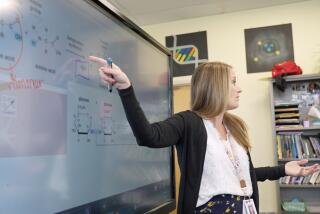These High Schoolers Study M for Murder
- Share via
HUNTINGTON, N.Y. — The woman’s body lay face down on the floor, blood dripping down her cheek. Her limp hand cradled a small pistol. It was black; her hair was blond.
The yellow police tape made it seem like a typical crime scene. But this was no ordinary murder. This was a classroom at Huntington High School.
A squad of detectives arrived. They were young, looked like rookies. One scooped up white powder next to the body. Another combed for carpet fibers. A third found what appeared to be marijuana buds.
“Where should I shoot?” asked crime scene photographer Kim Cohen.
“I don’t know. I guess by the body,” answered detective Maria Lepera.
Their confusion was understandable. Cohen and Lepera were not really detectives. The green substance was not marijuana; it was catnip. The white powder? Baking soda.
As for the body, it was a mannequin. Very convincing, too.
The entire scene was staged for a class in which the Long Island students read mystery literature, then perform the forensics described in the stories--hair analysis, toxicology screens, fingerprint dusting--in a science lab.
The Mystery and Forensics class was the brainchild of English teacher Barbara Weschke and science teacher Marguerite Montefusco.
The women realized last year how the crime novels that Weschke taught related to the class unit Montefusco taught on forensic science.
“She would tell me something, and I would say, ‘I read about that in Patricia Cornwell,’ ” Weschke recalled.
So they wrote a curriculum for a course offered by both departments, got it approved by a committee of teachers and parents and the school board, and joined forces.
Students in the one-semester elective course study mystery literature with Weschke. Then they go to Montefusco, where they practice investigating the crimes they read about.
For example, the class reads “The Murders in the Rue Morgue,” an 1841 story by Edgar Allan Poe. Since the culprit is an orangutan, students analyze human and animal hair fibers in the lab.
After reading “And Then There Were None,” the Agatha Christie novel about 10 people stranded on an island who are killed one by one, some by poison, students perform toxicology and blood-type testing (although Montefusco uses lead compounds instead of poisons).
Montefusco said the class tries to go “beyond book learning, actually applying knowledge of science to real life.”
That approach won praise from students as realistic and fun, although the course has a heavy workload. For the English portion alone, the fall-term final project was to write a mystery, sketch the evidence, interview a crime expert and write an essay on a crime issue.
Senior Eddie Jaramillo said the course helped inspire his interest in being a detective. “It’s the best class I’ve had all year.”
Added senior Kristen Haagenson, “I tell people in other schools I take this, and they say they wished they could.”
The science portion was on display at the recent final project, which featured the body. Students took photographs, sketched, collected evidence--hair and carpet fibers and fingerprints--in sealed bags and analyzed it under microscopes.
Montefusco paced the room like a strict, benevolent mother, offering advice and tart commentary.
“I hope you’re not picking that up with your fingers!” she said as Haagenson did just that with a glass vial next to the body. The girl sheepishly used tweezers.
The goal was to solve the crime --and a student was the culprit.
So, whodunit?
The team of seniors Haagenson, Amy Fisher, Yovani Campos and Jason Siragusa was stumped.
Siragusa dusted the vial--Montefusco had lifted prints covertly earlier in the semester from four students--but couldn’t find a match. Fisher determined that the hairs next to the body were human.
Suddenly, Haagenson spied a footprint on a desk above the body. She looked down at Siragusa’s brown Timberland shoes.
“It’s Jason!” she exclaimed.
Montefusco confirmed the verdict. The clues: the footprint, obtained earlier in the day from another student with the same shoes, and the fingerprints, which were Siragusa’s.
“I can’t believe she set me up,” said a laughing Siragusa.
His punishment: cleaning up the mess.
But Campos called for harsher measures. “Give him the chair!”
More to Read
Sign up for Essential California
The most important California stories and recommendations in your inbox every morning.
You may occasionally receive promotional content from the Los Angeles Times.










